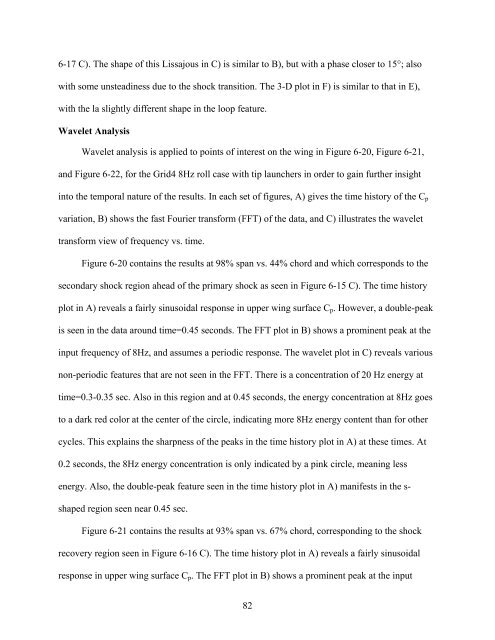university of florida thesis or dissertation formatting template
university of florida thesis or dissertation formatting template
university of florida thesis or dissertation formatting template
Create successful ePaper yourself
Turn your PDF publications into a flip-book with our unique Google optimized e-Paper software.
6-17 C). The shape <strong>of</strong> this Lissajous in C) is similar to B), but with a phase closer to 15°; also<br />
with some unsteadiness due to the shock transition. The 3-D plot in F) is similar to that in E),<br />
with the la slightly different shape in the loop feature.<br />
Wavelet Analysis<br />
Wavelet analysis is applied to points <strong>of</strong> interest on the wing in Figure 6-20, Figure 6-21,<br />
and Figure 6-22, f<strong>or</strong> the Grid4 8Hz roll case with tip launchers in <strong>or</strong>der to gain further insight<br />
into the temp<strong>or</strong>al nature <strong>of</strong> the results. In each set <strong>of</strong> figures, A) gives the time hist<strong>or</strong>y <strong>of</strong> the Cp<br />
variation, B) shows the fast Fourier transf<strong>or</strong>m (FFT) <strong>of</strong> the data, and C) illustrates the wavelet<br />
transf<strong>or</strong>m view <strong>of</strong> frequency vs. time.<br />
Figure 6-20 contains the results at 98% span vs. 44% ch<strong>or</strong>d and which c<strong>or</strong>responds to the<br />
secondary shock region ahead <strong>of</strong> the primary shock as seen in Figure 6-15 C). The time hist<strong>or</strong>y<br />
plot in A) reveals a fairly sinusoidal response in upper wing surface Cp. However, a double-peak<br />
is seen in the data around time=0.45 seconds. The FFT plot in B) shows a prominent peak at the<br />
input frequency <strong>of</strong> 8Hz, and assumes a periodic response. The wavelet plot in C) reveals various<br />
non-periodic features that are not seen in the FFT. There is a concentration <strong>of</strong> 20 Hz energy at<br />
time=0.3-0.35 sec. Also in this region and at 0.45 seconds, the energy concentration at 8Hz goes<br />
to a dark red col<strong>or</strong> at the center <strong>of</strong> the circle, indicating m<strong>or</strong>e 8Hz energy content than f<strong>or</strong> other<br />
cycles. This explains the sharpness <strong>of</strong> the peaks in the time hist<strong>or</strong>y plot in A) at these times. At<br />
0.2 seconds, the 8Hz energy concentration is only indicated by a pink circle, meaning less<br />
energy. Also, the double-peak feature seen in the time hist<strong>or</strong>y plot in A) manifests in the s-<br />
shaped region seen near 0.45 sec.<br />
Figure 6-21 contains the results at 93% span vs. 67% ch<strong>or</strong>d, c<strong>or</strong>responding to the shock<br />
recovery region seen in Figure 6-16 C). The time hist<strong>or</strong>y plot in A) reveals a fairly sinusoidal<br />
response in upper wing surface Cp. The FFT plot in B) shows a prominent peak at the input<br />
82
















